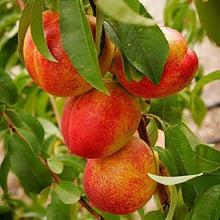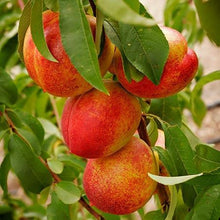Sweet Fruit on a Fast-Growing Fruit Tree
Sweet Delicious Fruit
The Surecrop Nectarine is a cousin of the peach. It looks and tastes similar to the peach, but has smooth skin, rather than fuzzy. The fruit is firm and separates from the core with ease. Eat fresh off of the tree from mid to late summer for a juicy, refreshing treat. Can them or freeze to enjoy throughout the year. They're delicious added to yogurt and ice cream.
Easy to Grow
You don't have to have to have a green thumb to successfully grow Surecrop Nectarines. In fact, it's considered the perfect "starter" tree for fruit growing. Plant in well-drained soil and full sunlight to get a large bounty of 3" nectarines every summer. We've groomed this tree at our nursery for years, so there is no waiting for you to receive fruit. You can expect your magnificent tree to produce nectarines your very first year.
Spring, Summer and Fall Interest
Great for a small space, a showy hedge, or as an accent tree, the Surecrop reaches 12-15 feet in mature height and 12-15 feet wide. Each spring it comes alive with bright green foliage and profuse pink flowers that attract hummingbirds. The beautiful flowers stay on the tree until mid-summer, when the tree begins to bare fruit. Then in the fall, the foliage transitions to yellow for perfect autumn color.
Order Now
This easy to grow nectarine tree is ready to be shipped out the very next day. Call and place your order now. Our Customer Service Specialists will answer any questions you may have.
Planting & Care
The Surecrop Nectarine (Prunus persica var. nucipersica 'Surecrop') is recommended for zones 5-9 and is hardy down to -10 degrees. With a mature height of 15 feet and width of 8-10 feet, it produces bright green foliage and beautiful fragrant pink flowers that often attract hummingbirds in the spring. Being a cousin of the peach, the fruit looks very similar but features a smooth, rather than fuzzy, golden skin with a red blush. The fruit is large, succulent and sweet bearing a mild acidity making it perfect to enjoy right off the vine or in your favorite baked good. Fruit is ready for picking in mid to late summer.
Location: Plant your nectarine tree in well-drained soil in a location where it will receive full sun (at least 6-8 hours of sunlight a day). Heavy winds and early frosts can damage the blossoms, so be sure to protect your tree by planting on the sunniest side of a building or your home.
Planting Instructions: Select an area where your soil drains well and the tree will receive at least 6-8 hours of sunlight a day.
1) Dig a hole twice as wide as the root ball and just as deep. Amend the soil around the hole with compost to ensure the tree has proper drainage.
2) Place your tree inside the hole making sure it is sitting straight and that the graft is 2 inches above the soil line.
3) Cover the roots with soil, watering occasionally as you go along to remove any air pockets that may have formed. Gently pat the soil down until the roots are completely covered.
4) Broadcast mulch around the base to conserve soil moisture and keep competing growth back.
Watering: Keep the soil around the tree moist, but not saturated. Standing water around the roots can cause rot damage and kill your tree. Typically watering once a week by leaving a hose at the base of the tree for a couple of hours is sufficient. Once the soil around the tree has dried, water the tree again. During times of extreme heat, your tree may need additional water. Yellowing of the leaves is a sign of over watering while leaves that are dry and brown can be a sign of under watering.
Fertilization: After your tree has been in the ground for 6 weeks and the dangers of frost has passed, apply a well balanced balanced fertilizer formula such as 12-12-12 but be sure to follow the application instructions on the packaging. This should be done in the spring and summer.
Pruning: Your Surecrop Nectarine will need to be pruned the first two years in order to maintain an open center shape and encourage fruit production. Prune your tree in late winter or early spring using pruning shears and making your cuts at a 45-degree angle. Trim away any broken/dead branches and any that are criss-crossing by making your cut right below the dead wood. To achieve the open center shape, prune your tree so that the center section has only two or three main branches that will receive plenty of sunlight.
Pests: Check your tree regularly for insects and diseases. Caterpillars can form nests (egg sacs) on the tree which should be picked off immediately and spray your tree with a horticultural oil or an insecticide. Fungus can be treated by spraying a fungicide on the tree while it’s blooming.
Tips: Once your tree begins to fruit, thin your nectarines out to allow each 8 inches in space to grow and mature properly. Thinning out your fruit will help to increase your overall production. Nectarines on the top and outside of the tree will likely be ready to pick first.



